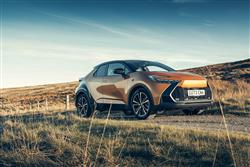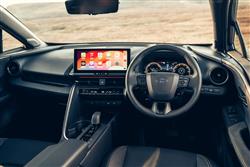Toyota C-HR - ABC Leasing
How will you view?
This is a sample, showing 30 seconds of each section.
A MORE SENSIBLE FASHION STATEMENT(some text hidden)
By Jonathan Crouch
Ten Second Review word count: 53
This second generation C-HR takes the successful formula established by its predecessor and improves it in most key areas. Which means this small coupe crossover is a little better to drive, slightly more practical and, arguably, smarter to look at too. There's even now 4WD and Plug-in Hybrid tech if you want it.
Background word count: 204
Toyota's been producing so-called 'European' cars for decades, but the C-HR, originally launched back in 2017, was the first one that really felt properly targeted at the preferences of our continent. This small coupe-crossover was built in Europe (just about - in Turkey), developed in its capital (Brussels) and sold like hot cakes, quickly becoming the brand's fourth best selling model, with 59% of customers poached from other manufacturers. So hopes were high for this, the second generation C-HR, introduced by Toyota in the Autumn of 2023. Since the old car sold mainly on its appearance, this one's evolved styling needed to look sharp, keeping it at the fashionable end of the segment for small crossovers (a Volkswagen T-Roc or Taigo rival, rather than a T-Cross competitor, if that helps to pigeonhole it for you). Yet this time round, the designers have tried to balance those looks with more practical rear seat and boot space. Plus the Hybrid engine range has been broadened with the addition of a PHEV variant to give this model line longevity in markets about to make the switch to full EVs. And the front-of-cabin experience is now better connected and more premium. Sounds promising. Let's take a closer look.
Driving Experience word count: 427
The C-HR has always set its stall out to be 'sporty' and this second generation version is no different. This time round, the car needs less mental adjustment if you're coming to it from a model without a fully-electrified powertrain. Though you might not expect that because at first glance, the core engines on offer here - 1.8 and 2.0-litre full-Hybrids - seem much the same as they were in later versions of the previous version. Actually though, much is different. As before, you're never quite certain where the source of motion power is coming from - generator, battery or engine. And, also as before, heavy throttle applications see the left hand power meter dial reading lurching violently back and forth like a windmill. But this time round, a better optimised level of throttle calibration means that there's far less lag between requesting extra acceleration and it being actually delivered. Nor is the 'elastic band' 'moo-ing' of the e-CVT auto gearbox quite as prominent. On undulating roads, new Adaptive Hill Control Logic modifies acceleration according to the incline. And for quieter running, engine speeds during highway driving have been reduced by up to 500rpm, improving refinement. The Hybrid engines have more power too - with the 1.8-litre VVT-i unit almost everyone will still choose up from 122 to 138bhp, taking nearly a second off the 0-62mph sprint time (now 10.2s) and, more importantly, boosting mid-range pulling power by a significant 43Nm (now 185Nm), enough to make overtaking that swaying artic in front slightly less of a white-knuckle affair than it was before. As with the old car, there's also a larger-capacity 2.0-litre version of this Hybrid powertrain available - which also gets more power, up from 182 to 195bhp. We tried that and it propels this Toyota along with more of the kind of urgency its rakish looks suggest it ought to have, with 206Nm of torque and 62mph dispatched in a far more satisfying 8.1s. That larger engine also provides the basis for a newly-introduced PHEV twin-motor drivetrain with a useful 223bhp total output, which dispatches the 62mph sprint in 7.3s. That's despite the extra weight of a 13.8kWh battery that when fully-charged is supposed to be able to take you up to 41 miles between spells of replenishment. But that's a weightier model that won't have the appealing agility of the more ordinary conventional Hybrid variants, which benefit from the installation of the brand's stiff new TNGA-C chassis. Ride quality's on the firm side, but in compensation, the car feels well planted through the turns.
Pictures (High res disabled)

.jpg)
.jpg)
.jpg)
.jpg)
.jpg)
.jpg)
.jpg)
.jpg)
.jpg)

Scoring
Category: Compact Car
| Performance | |
| Handling | |
| Comfort | |
| Space | |
| Styling | |
| Build | |
| Value | |
| Equipment | |
| Economy | 80% |
| Depreciation | 70% |
| Insurance | 70% |
| Total | 68% |